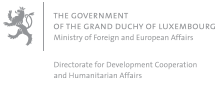- Home
- Preface
- European Year for Development
- COP21 and the Paris Agreement
- I. Luxembourg’s official development assistance in 2015
- II. Cooperation with the main partner countries
- III. Regional cooperation and cooperation with other countries
- IV. Multilateral cooperation
- V. European Union
- VI. Cooperation with non-governmental development organisations
- VII. Humanitarian action
- VIII. Programme support
- IX. Development education and awareness raising
- X. Inclusive finance
- XI. Evaluation
- XII. Report on the progress of the work of the Interministerial Committee for Development Cooperation
- Appendices
COP21 and the Paris Agreement

COP21 and the Paris Agreement
2015 was the year of successive negotiations
i) on financing for development, which led in July to the adoption of the Addis Ababa Action Agenda, and
ii) on the 2030 Agenda for Sustainable Development, which was adopted in September with its 17 Sustainable Development Goals, and
iii) COP21 in December, which successfully led to the adoption of the Paris Agreement. The challenge was to ensure the integration of climate change into the first two frameworks without damaging the results of COP21 and while remaining within the bounds of the respective fields of competence and ensuring their consistency.
On 12 December 2015, at the conclusion of COP21 in Paris, the first agreement on climate change with universal scope and legally binding force was adopted. The Directorate for Development Cooperation closely followed the climate negotiations and is assisting developing countries, especially its partner countries which are among the most vulnerable ones, to implement their actions to mitigate and adapt to the impacts of climate change. We must listen to developing countries and ensure that the Paris Agreement is in line with, and benefits, the development agenda.
The principle of common but differentiated responsibilities (CBDR) had governed climate negotiations since the adoption of the United Nations Framework Convention on Climate Change in 1992 in Rio. At the negotiations leading to the Paris Agreement, the task for developed countries (including those of the European Union) was to overcome a division of the world along 1992 lines – one that is no longer valid today – in order to arrive at a contemporary definition which takes into account countries’ respective capabilities, given their different national circumstances. With differentiation remaining central to the Paris Agreement, the international community has formulated a joint response to the challenge of combating climate change whereby all the countries in the world are committed to do their part, thus achieving a critical mass of global emissions reductions.
All parties will have to propose their intended nationally determined contributions (INDC) and review them upwards every five years (a so-called “mechanism of ambition”). 189 countries have done this so far, which provides a pathway for achieving the required economic transition.
For developing countries, adaptation to the impacts of climate change plays a critical role that the Paris Agreement must reflect. Over 80% of INDCs are focused on adaptation, which reflects not only the vulnerability of developing countries but also the role of the agricultural sector, which is particularly exposed to climate hazards, in their economies. Article 7 of the Paris Agreement, which focuses on adaptation, has a goal for adaptation linked to the temperature goal, responding to a demand by developing countries to that end. Continued, strengthened support for developing countries is also specified, as well as a global stocktake in order to determine whether the efforts made are adequate. Institutional systems will also be strengthened.
The losses and damage suffered by developing countries as a result of climate hazards were the subject of difficult negotiations which touched on sensitive issues of responsibility and possible compensation – a “no-go area” for developed countries. The fact that losses and damage are addressed in the Paris Agreement under a separate article (art. 8) has provided comfort to the most vulnerable countries.
Capacity-building is addressed in Article 11 of the Paris Agreement: developed countries commit to support developing countries in implementing adaptation and mitigation measures, having access to technology and financing, undertaking training, awareness-raising and communication activities as well as complying with the transparency framework and the provisions specified therein for monitoring, reporting and verification.
In terms of climate finance, in Paris, developed countries undertook to draw up a concrete road map to provide the 100 billion dollars per year by 2020. A new, more ambitious goal will have to be established by 2025 at the latest. However, these provisions are only specified in the decisions accompanying the Paris Agreement and not in the Agreement itself, something which has certainly left developing countries – for which the question of climate finance is crucial – dissatisfied. We should note at this point that Luxembourg has committed i) to make 120 million euros available for international climate finance, of which 35 million euros will be allocated to the Green Climate Fund, ii) to apply its financing evenly to mitigation and adaptation, and iii) to apply the principle of additionality between climate finance and official development assistance.
The factors which made COP21 a success included unprecedented political mobilisation, the commitment of the French chairing of the COP21 (above all with regard to developing countries, where a large number of initiatives, especially for access to renewable energy, have been launched) the building of the negotiators’ capacities to be up to speed with the increasingly complex, wide-ranging negotiations and the creation of alliances such as the “High Ambition Coalition”, which brought together over 100 countries, thus overcoming the fault lines between developed and developing countries.
In conclusion, we can say that the Paris Agreement is a success for everyone: not only are all the large economies involved in combating climate change but the trajectories for transition also offer opportunities for developing countries which they must grasp.

